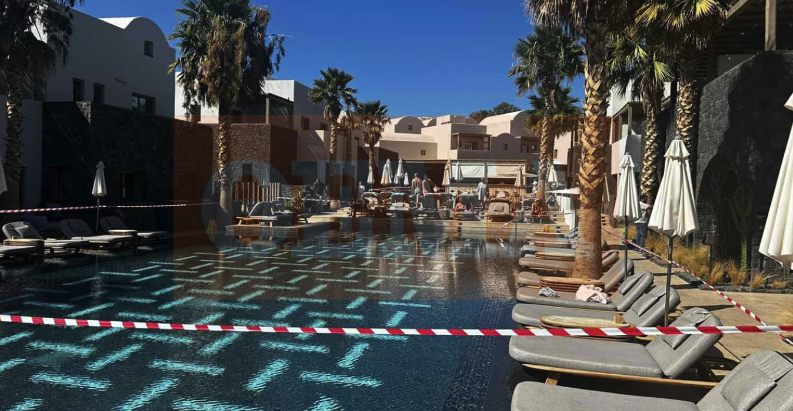Andreas Syngros: Nouveau riche fraudster or national benefactor?
Source: ProtoThema English
“Chrysokantharos”, meaning nouveau riche, plutocrat – or a great national benefactor?
A ruthless opportunist, a “national thief” – or by far the most astute businessman of his era and a brilliant national asset?
We are talking about Andreas Syngros, one of the leading figures in Greece during the second half of the 19th century, but perhaps the most controversial. The answers are deeply complex, full of caveats and uncertainties – regarding the quality of the man, the businessman, the banker, the politician, the philanthropist, and the benefactor. Because Syngros was all of these. A human “laboratory” of characteristics.
The epitome – arguably the most characteristic Greek example – of a self-made entrepreneur, who refused to follow his physician father’s plan for him to inherit the profession. In very little time, he built a legendary fortune, using, according to many, every legal and illegal means available. This placed him under the harshest criticism.
Yet he was the one who donated his entire fortune to the state and Greek society – parts of which were utilized even while he was still alive, and most of it after his death. With the decisive involvement of his wife, Iphigenia.
Indeed, the impact of his multi-level, high-cost contribution to society is still clearly visible today in many parts of Athens and beyond.

He was ruthlessly accused of being a harsh profiteering lender to the Greek state, and also of leading thousands of small shareholders in the Lavrion Mining Company into financial ruin via an orchestrated stock market bubble. Some even blamed him for pushing the country into the 1893 bankruptcy.
On the other hand, no one could question his role as a benefactor. A national benefactor. Many, of course, attributed his great donations to a calculated effort to muddy the waters – a “smokescreen” of philanthropy to cover the fact that in his quest for wealth he was “stepping over corpses.”
The Beginning
Andreas Syngros was born in Constantinople exactly 195 years ago, on October 12, 1830.
His parents, Domenikos and Nikoleta, were from Lithí, Chios. They married in 1820 and survived the horrors of the 1822 Massacre of Chios. After wandering through Tinos, Mykonos, and Constantinople – as Domenikos Syngros was a prominent physician educated in Pisa – they returned to Andros in 1834.
Andreas Syngros: Nouveau riche fraudster or national benefactor?
Syngros is recognized by most historians as the second most important Greek figure from 1850 to 1900, after King George I. Their two sons, Georgios and Andreas, attended the renowned school of Theophilos Kairis, and later, when that closed, the Scolarchion of Ermoupolis in Syros. This was a turning point in Andreas’s future path. Instead of continuing his studies, in 1845 he joined the business of Theodoros Rodokanakis as an apprentice clerk. Just three months later, he traveled to Constantinople – at the age of just 15. There, he found work in the business of a textile and silk merchant, Nikolaos Damianos, as a junior clerk (“tritos grammatikos”). Soon, thanks to his talent and undeniable abilities, he gained the trust of his employer. So much so that when his superior resigned in 1847, Damianos appointed young Syngros in his place. Just two years later, at age 19, Syngros took over the management of the company, as Damianos had fallen gravely ill and died.
It was his “passport” into the dominant class of major merchants, bankers, and the powerful moneyed elite of Constantinople.
His first successes involved highly profitable chartering of ships to transport goods he had pre-purchased at low prices. With just two such deals, he tripled his fortune. In 1855, he purchased 4% of the company E.M. Bouros & Co. He expanded his activities by securing government supply contracts from the Ottoman Empire. By 1857, he was exporting silk from Asia Minor, Thrace, and Thessaly to France, bringing his company a profit of over 1 million francs. In 1861, he founded a new company: Syngros, Koronios & Co. By then, he had acquired significant liquidity. Thus, he began lending to the Turkish state at exorbitant interest rates, exploiting its urgent need for funds.
In 1867, Syngros traveled to Athens.
He met with the then Minister of Foreign Affairs, Charilaos Trikoupis, but more importantly, he met King George I himself, as well as numerous other officials and influential figures. As a result, two years later, under Prime Minister Thrasyvoulos Zaimis, when the Greek State found itself in a fiscal deadlock, it turned to Syngros for a loan. Through his company, he responded by offering a first installment of 6 million drachmas. He also founded the Bank of Constantinople, through which he continued to lend to the faltering Ottoman state, under very harsh terms — with interest rates reaching up to 20%.
In 1872, he permanently settled in Athens.
With the incorporation of Thessaly in 1881, he bought numerous large estates at bargain prices from panicked Turkish landowners. At the same time, together with the National Bank of Greece, he founded the Epirus-Thessaly Bank, gaining the exclusive right to issue and circulate banknotes in the so-called “New Territories”. However, the Greco-Turkish War of 1897 disrupted his plans, and two years later the bank merged with the National Bank. In 1882, he founded the Panhellenic Steamship Company and loaned the Municipality of Athens 225,000 drachmas.
The Lavreotika Scandal
The Lavreotika is considered the first major economic, business, and stock market scandal in modern Greek history — and Syngros played a central, negative role. In 1869, the government of Alexandros Koumoundouros, with Finance Minister Epameinondas Deligeorgis leading the charge, was in a bitter dispute with the French company Roux-Serpieri-Fressynet C.E., which was operating the mines of Lavrio. The central issue: the slag heaps (the remnants of mined ores) lying on the ground, which the government considered national property.

The Government Suspends the Company’s Operations
The government suspended the company’s operations. By law, it banned the use of the slag heaps and taxed Serpieri at 60% on his net profits. He disagreed but instead of appealing to the courts, he sought the support of the major European powers. Those powers went so far as to threaten a naval landing in Greece. What followed was a massive political crisis within the country.
At the same time, a completely unfounded rumor was circulating about the existence of gold deposits in the mines.
Serpieri demanded 20 million drachmas to return the mines to the state—a sum well below their estimated value, yet unaffordable for the financially weak Greek government.
Enter Syngros
In its search for a solution, the government began looking for a Greek buyer.
Syngros stepped in, and in 1873, he bought 50% of the company, paying 11.5 million francs and transferring the shares to the Bank of Constantinople. Serpieri remained co-owner, and together they founded the Hellenic Company of Metallurgy of Lavrio. They continued to cultivate rumors about gold and converted the company into a joint-stock company. The initial capital was set at 14 million francs, corresponding to 100,000 shares. Demand was more than tenfold. Thousands of Athenians, lured by the promise of quick and high returns, rushed to buy shares. And since there was no official stock exchange, a drama of the primitive Greek market unfolded at the café “Oraia Hellas”, where such transactions took place. Shares worth 200 drachmas were sold for up to 310 drachmas. Everyone, wealthy or not, was buying frantically. People sold homes, plots of land, and farmland to invest.
The Stock Market Crash
The bubble burst when the company announced a delay in paying the third dividend installment.
Panic erupted. The share price collapsed, and thousands lost their fortunes. The scandal was enormous, with deep social, economic, and political repercussions. The press unanimously blamed Syngros, labeling him a ruthless speculator responsible for the economic ruin of thousands of citizens.
The Bankruptcy of 1893
True to his motto, “Whenever I smell a profitable venture, I can’t resist”,
Syngros participated in a multitude of business ventures —
including the Athens–Lavrio railway, the construction of the Corinth Canal, the draining of Lake Stymphalia, and the Athens–Piraeus Railway Company. He also entered politics, reaching the rank of Member of Parliament, though never holding higher office. He was elected multiple times, always as an independent. He clashed repeatedly with Prime Minister Theodoros Deligiannis and was seen as the main reason for the collapse of Deligiannis’s government. He even submitted a memorandum to King George, warning that extending the government’s life posed serious risks to the economy. Immediately after the fall of the Deligiannis government, Syngros participated with a large share in a 16 million franc loan to the Greek state. However, the new Trikoupis government found itself in complete financial deadlock. Public debt had increased sevenfold, exports had plummeted, and the currant crisis had broken out. Syngros was accused by the press and politicians of attempting to engineer the bankruptcy of the country through speculative tactics, with the hidden aim of acquiring the National Bank of Greece and founding a “Bank of the State.” Indeed, as part of this plan, he persuaded King George to reject a British loan of 3.5 million pounds, which could have saved Greece from default. Trikoupis was forced to resign, but won the October 1893 elections. Upon his return, he tried to secure a new loan from London, but failed. On December 10, 1893, Greece declared bankruptcy.
Final Years and Death
In the 1899 elections, Syngros was re-elected MP for Attica, receiving 15,139 votes.
But on February 13, he passed away from a heart attack. In his turbulent life, he also fathered an illegitimate son, Georgios Nomikos, whom he included in his will, leaving him vast estates in Euboea and Thessaly, but never formally recognized him.
Marriage
Iphigenia Syngrou, daughter of Ioannis and Aglaia Mavrokordatos, was born in 1842.
Beautiful and noble in appearance, she captivated the bachelor-by-choice Andreas Syngros. They married on Easter Day, 1875. They lived together for 24 happy years, though they had no children.

She devoted her entire life
She devoted her entire life to protecting children, especially orphans and families in need, and is considered the inspiration and driving force behind most of Syngros’s philanthropic initiatives.
After her husband’s death, she worked on the publication of his memoirs and the completion of his charitable donations. She passed away in 1921.

The Philanthropy of Andreas Syngros
The philanthropic work of Andreas Syngros is immense. Regardless of his motives, he was rightfully given the title of “National Benefactor.”
At his side constantly was his wife Iphigenia, who ensured that after his death, his philanthropic vision would be fulfilled.
Syngrou Avenue
Its construction began in 1898, based on plans by military engineer Ioannis Genissarlis.
Earlier, the Athens municipal council had decided to name the under-construction road after Andreas Syngros—an obvious incentive.

He then decided to fund it so generously that it became the largest road in the capital.
After his death, his wife ensured the necessary funds were provided to continue the project.
The new road had a length of 5 kilometers and a width of 28 meters—12 meters for the main road and 16 meters for sidewalks on both sides.
The construction (including embankments, etc.) cost 750,000 drachmas, and approximately 460,000 drachmas were spent on compensation for adjacent property owners.
Its complete construction and paving were finished during Eleftherios Venizelos’s administration (1928–1932).

“Andreas Syngros” Hospital
Due to the terrible conditions at the existing state venereal diseases hospital since 1850, Syngros supported the construction of a modern facility.
In addition to the initial funding, his will left a significant additional sum for this purpose.
It opened on January 4, 1910—the only one of its kind in Europe at the time, and the most advanced in the world.
“Evangelismos” Hospital
On March 25, 1881, the foundation stone was laid by King George I.
Exactly three years later, the hospital was inaugurated and officially opened on April 16, 1884, under the stewardship of a women’s committee, with Iphigenia Syngrou as president.
Thanks to a donation from Andreas Syngros, the Sisters’ Home was completed in 1898—six two-story buildings that became the Syngros Wing.
This marked the beginning of the great history of Evangelismos, which evolved into the largest hospital in the Balkans.
Athens Municipal Theatre
The construction of the Athens Municipal Theatre, located at today’s Kotzia Square, was based on plans by renowned architect Ernst Ziller.
It was initiated by King Otto in 1857 but was halted, and finally in 1887, Andreas Syngros funded the completion of the unfinished building.
When finished, it was a beautiful theatre, with balconies, a painted ceiling, a large parterre, and excellent acoustics—but lacked heating and ventilation.
It was finally inaugurated in October 1888 by King George.
In 1898, as stipulated by Syngros’s donation, it was transferred to the Municipality of Athens.
The theatre experienced many glorious moments, hosting great performers, including the legendary Sarah Bernhardt.
After the Asia Minor Catastrophe, it was used to house refugees and suffered significant damage.
In 1927, renovation attempts failed.
In June 1940, during Mayor Ambrosios Plytas’s term and under Interior Minister Kostas Kotzias, the theatre was ordered to be demolished.
Andreas Syngros Mansion
The neoclassical mansion at Vasilissis Sofias & Zalokosta Streets began construction in 1872 and was completed a year later—also a Ziller project.
It belonged to Andreas Syngros, and that’s how it got its name. The land cost him 65,000 drachmas.
Through Iphigenia’s will, the mansion was bequeathed to the Greek State after her death “to serve permanently as the premises of the Ministry of Foreign Affairs.”
Today, it houses the central office of the Ministry.
In 1976, it was declared a protected work of art by the Ministry of Culture.
Syngros Estate
The Syngros Estate, covering 950 acres, lies at the borders of Kifissia, Maroussi, and Melissia.
Its first successive owners were British archaeologists Stean and Will.
Syngros bought it from the latter in 1881.
The estate was essentially the grounds of the magnificent Syngros Villa, consisting of manicured gardens, ponds, auxiliary buildings, and a cultivation system.
There were homes for workers, stables, carriage houses, an olive press, and a flour mill.
Among the most important surviving structures are the cattle shed and a small church:
Saint Andreas, a rare example of gothic-style Orthodox architecture, designed by Ziller, and the only one of its kind in Greece.
The entire Syngros Villa and estate were donated to the Greek state.
Syngros Prisons
The Syngros Prisons were built around 1888, with most of the construction cost covered by Andreas Syngros. Today, workers’ (initially refugee) apartment blocks are built on the site, behind Tavros Town Hall.
Olympia Museum
The Old Archaeological Museum of Olympia, neoclassical in style and once called “Syngreion”, was built thanks to a donation of 220,000 drachmas from Andreas Syngros. Excavations in Olympia made the construction of a proper building necessary to house the findings. Syngros commissioned two German architects and archaeologists, Wilhelm Dörpfeld and Friedrich Adler. Construction began in 1885 on Drouva Hill, west of the Altis, and was completed in 1888.
Later, the building suffered damage from frequent earthquakes in the area.
The growing number of new findings led to the need for a larger museum, which now stands in Olympia.
The old museum, now renovated and expanded, operates as the Museum of the History of the Ancient Olympic Games.
Delphi Museum
The Archaeological Museum of Delphi showcases the history of the famed sanctuary and most renowned oracle of the ancient Greek world. Its rich collections include architectural sculptures, statues, and miniature artworks, offered as votive dedications. The museum consists of two wings and was constructed in 1903 based on designs by French architect Albert Tournaire, with a donation from Andreas Syngros, to house the findings of the major French excavation that had begun in 1892. The museum underwent two renovations, in 1958 and 1999, with designs by Patroklos Karantinos and Alexandros Tombazis, respectively.
Ask me anything
Explore related questions
The original article: belongs to ProtoThema English .





